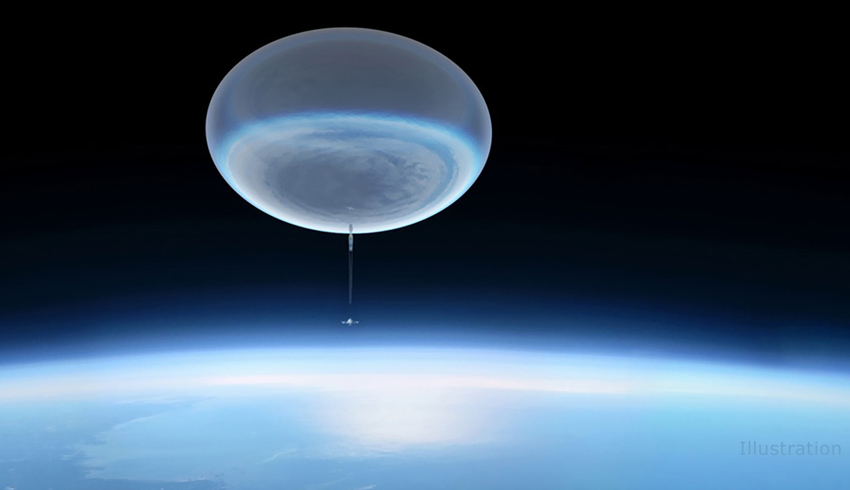Tentatively planned to launch in December 2023 from Antarctica, ASTHROS (short for Astrophysics Stratospheric Telescope for High Spectral Resolution Observations at Submillimeter-wavelengths) will spend about three weeks drifting on air currents above the icy southern continent and achieve several firsts along the way.
Managed by NASA's Jet Propulsion Laboratory, ASTHROS observes far-infrared light, or light with wavelengths much longer than what is visible to the human eye. To do that, ASTHROS will need to reach an altitude of about 130,000 feet (40 kilometres) – roughly four times higher than commercial airliners fly.
Though still well below the boundary of space (about 100 kilometres above Earth's surface), it will be high enough to observe light wavelengths blocked by Earth's atmosphere.
The mission team recently put the finishing touches on the design for the observatory's payload, which includes its telescope (which captures the light), its science instrument, and such subsystems as the cooling and electronic systems. In early August, engineers at JPL will begin integration and testing of those subsystems to verify that they perform as expected.
While balloons might seem like antiquated technology, they offer NASA unique advantages over ground- or space-based missions. NASA's Scientific Balloon Program has been operating for 30 years at Wallops Flight Facility in Virginia.
It launches 10 to 15 missions a year from locations around the globe in support of experiments across all of NASA's science disciplines, as well as for technology development and education purposes.
Balloon missions don't only have lower costs compared to space missions, they also have shorter times between early planning and deployment, which means they can accept the higher risks associated with using new or state-of-the-art technologies that haven't yet flown in space.
JPL engineer Jose Siles, project manager for ASTHROS, explained, “Balloon missions like ASTHROS are higher-risk than space missions but yield high-rewards at modest cost.”
These risks may come in the form of unknown technical or operational challenges that can impact a mission's science output, by working through these challenges, balloon missions can set the stage for future missions to reap the benefits of these new technologies.
ASTHROS will carry an instrument to measure the motion and speed of gas around newly-formed stars. During flight, the mission will study four main targets, including two star-forming regions in the Milky Way galaxy.
It will also, for the first time, detect and map the presence of two specific types of nitrogen ions (atoms that have lost some electrons). These nitrogen ions can reveal places where winds from massive stars and supernova explosions have reshaped the gas clouds within these star-forming regions.
“With ASTHROS, we're aiming to do astrophysics observations that have never been attempted before. The mission will pave the way for future space missions by testing new technologies and providing training for the next generation of engineers and scientists,” Siles added.
In a process known as stellar feedback, such violent outbursts can, over millions of years, disperse the surrounding material and impede star formation or halt it altogether. But stellar feedback can also cause material to clump together, accelerating star formation. Without this process, all the available gas and dust in galaxies like our own would have coalesced into stars long ago.
ASTHROS will make the first detailed 3D maps of the density, speed, and motion of gas in these regions to see how the newborn giants influence their placental material. By doing so, the team hopes to gain insight into how stellar feedback works and to provide new information to refine computer simulations of galaxy evolution.
Because far-infrared instruments need to be kept very cold, many missions carry liquid helium to cool them. ASTHROS will instead rely on a cryocooler, which uses electricity (supplied by ASTHROS' solar panels) to keep the superconducting detectors close to minus 268.5 degrees – a little above absolute zero, the coldest temperature matter can reach.
The cryocooler weighs much less than the large liquid helium container that ASTHROS would need to keep its instrument cold for the entire mission. That means the payload is considerably lighter and the mission's lifetime is no longer limited by how much liquid helium is on board.
The team expects the balloon will complete two or three loops around the South Pole in about 21 to 28 days, carried by prevailing stratospheric winds. Once the science mission is complete, operators will send flight termination commands that separate the gondola, which is connected to a parachute, from the balloon.
The parachute returns the gondola to the ground so that the telescope can be recovered and refurbished to fly again.
A division of Caltech in Pasadena, JPL manages the ASTHROS mission for the Astrophysics Division of NASA's Science Mission Directorate. JPL is also building the mission payload. The Johns Hopkins Applied Physics Laboratory in Maryland is developing the gondola and pointing systems.

